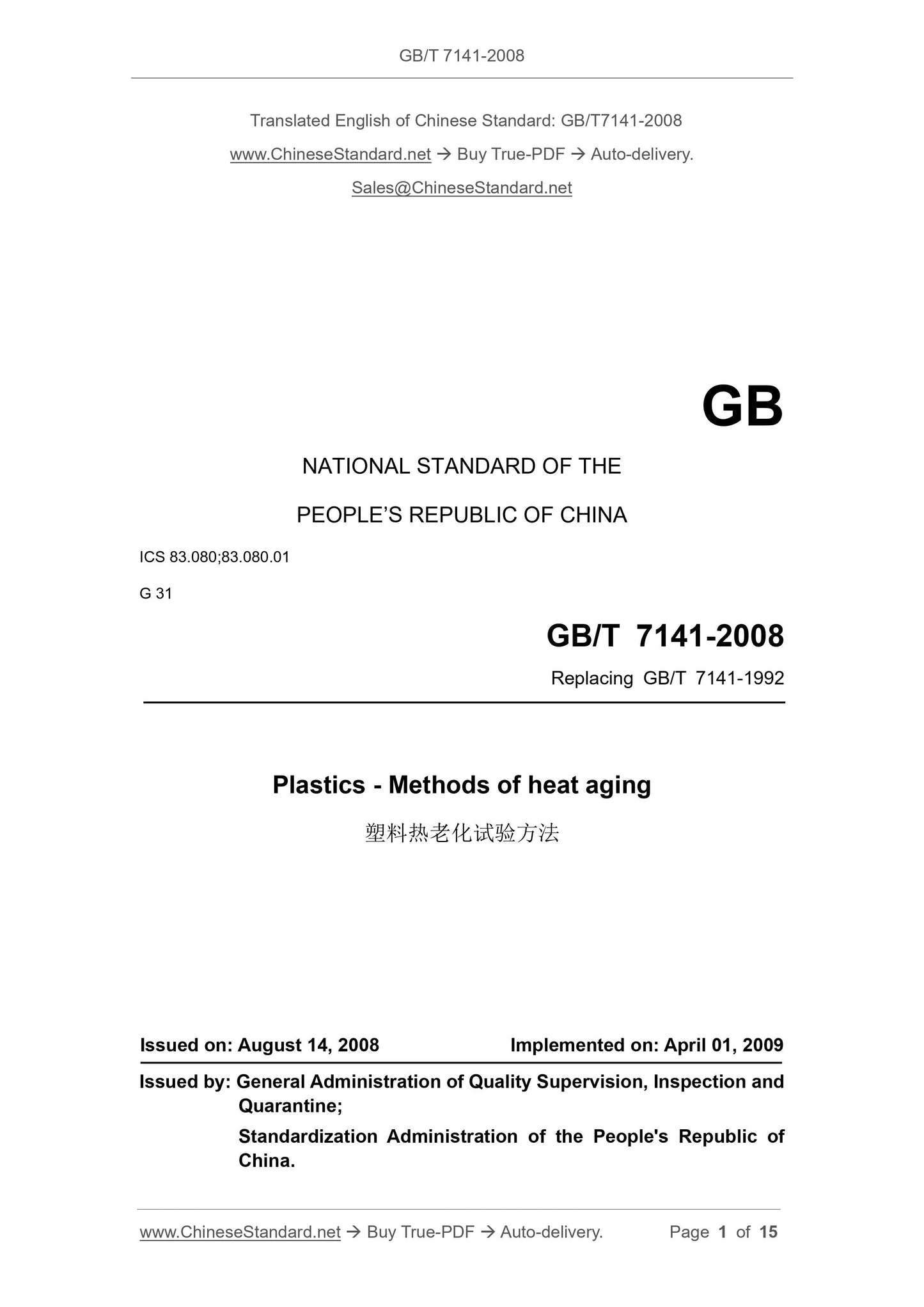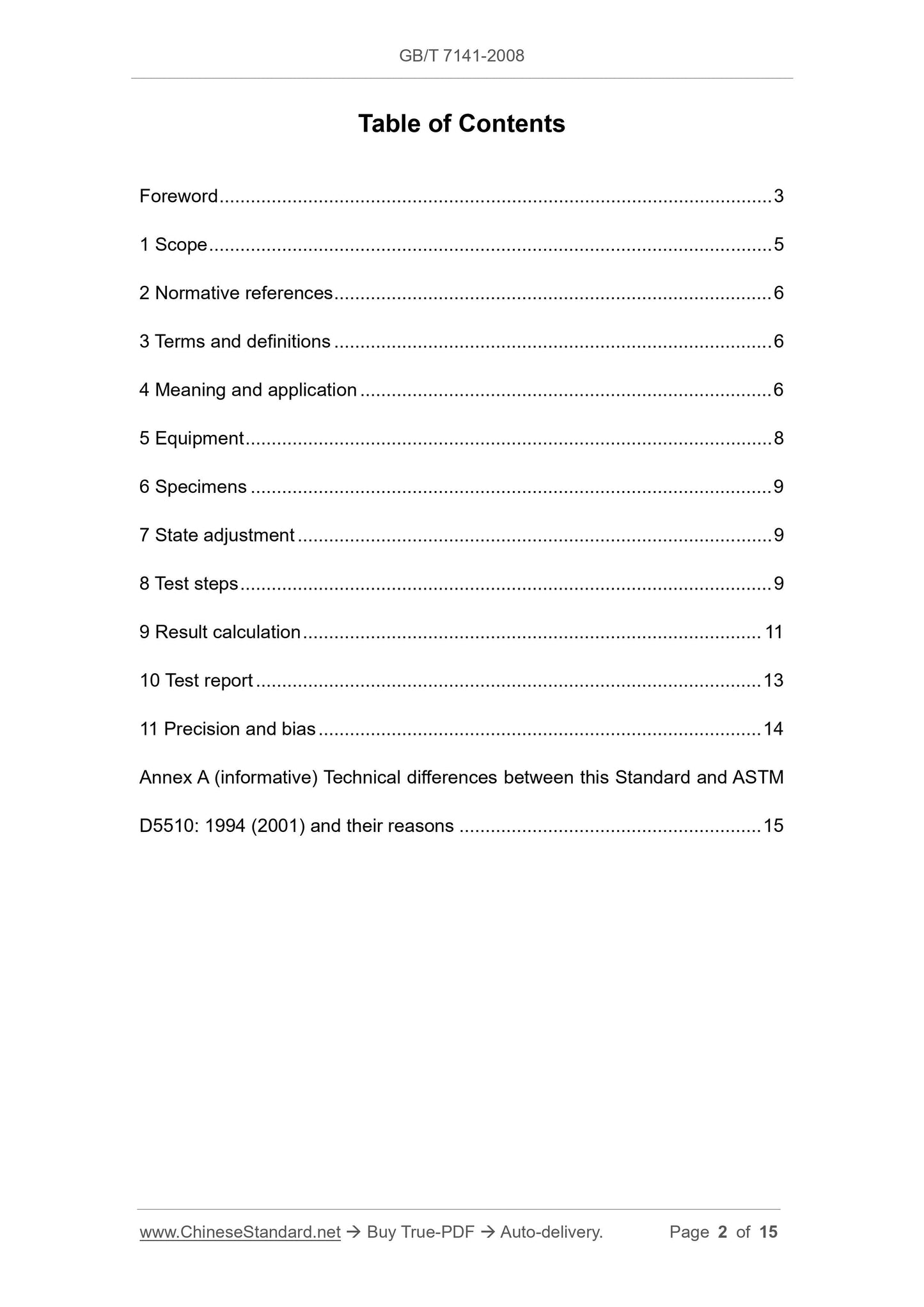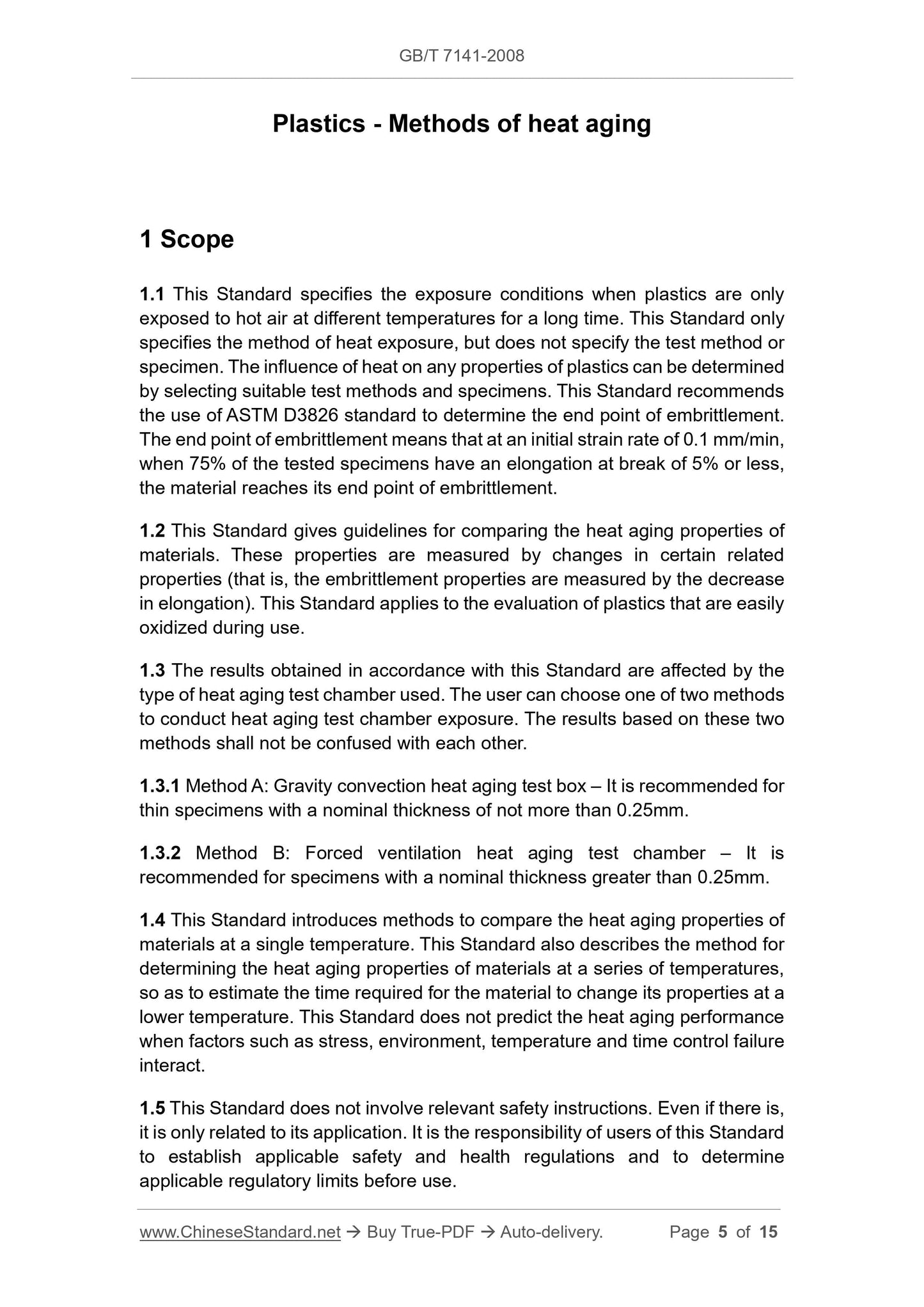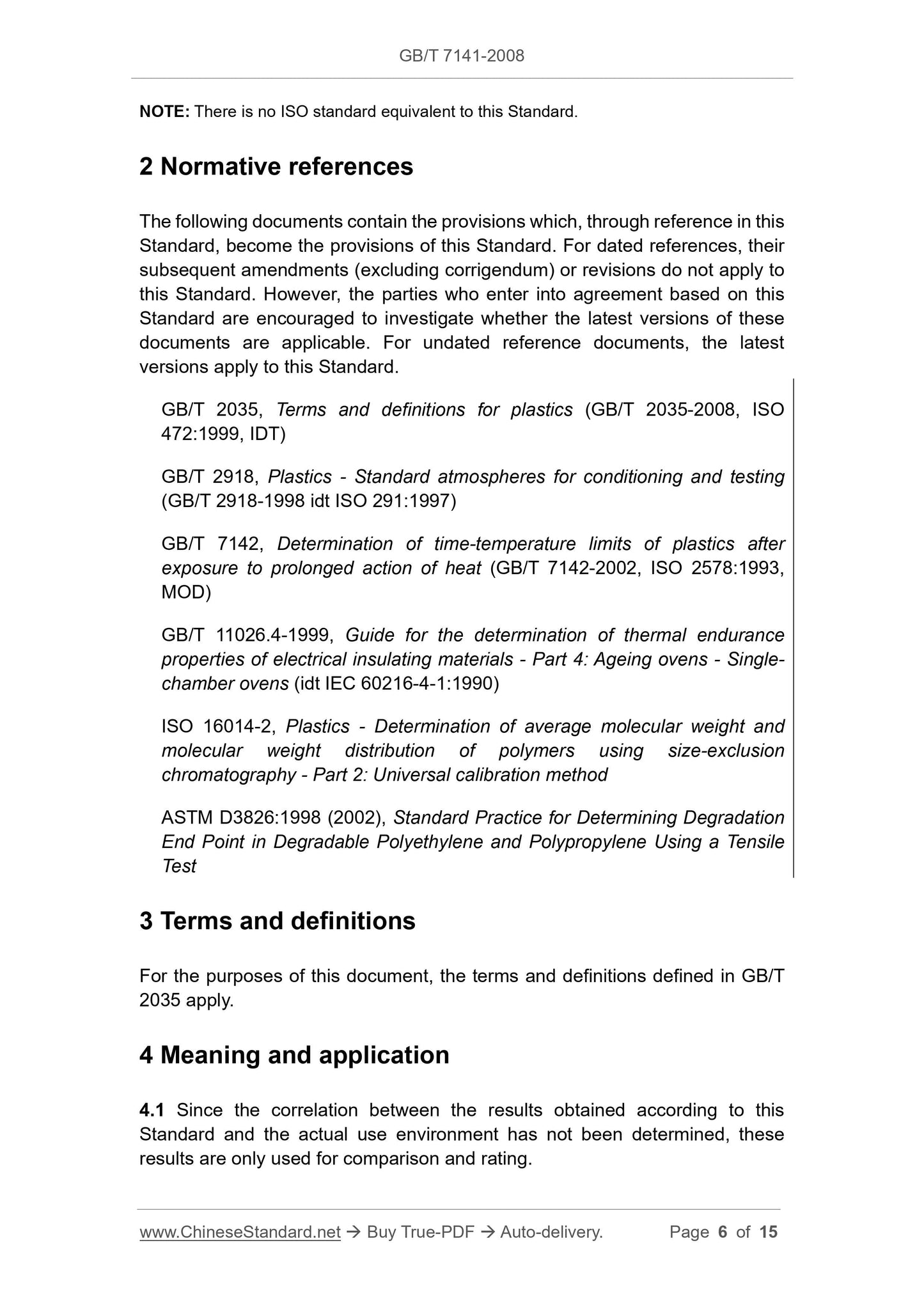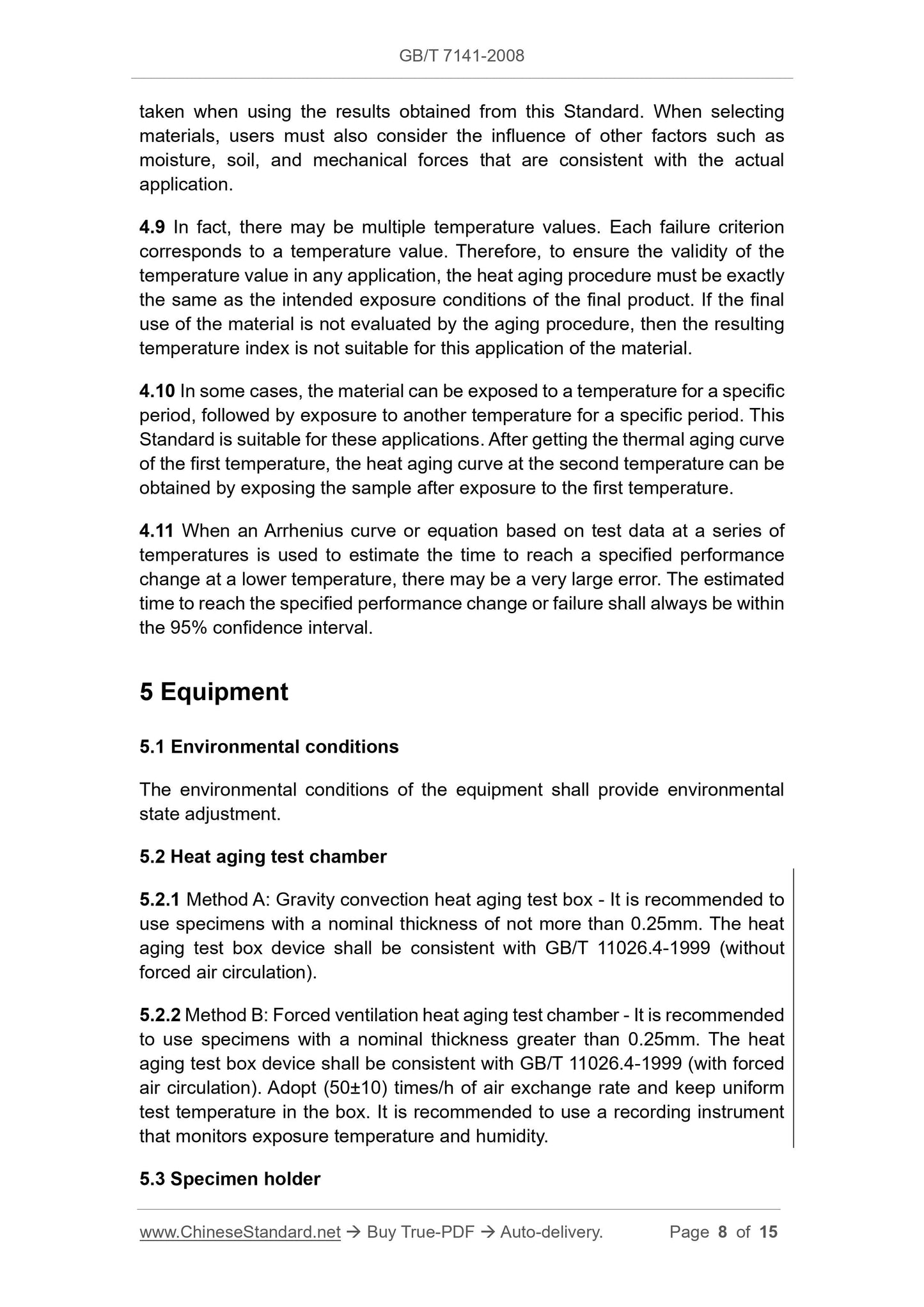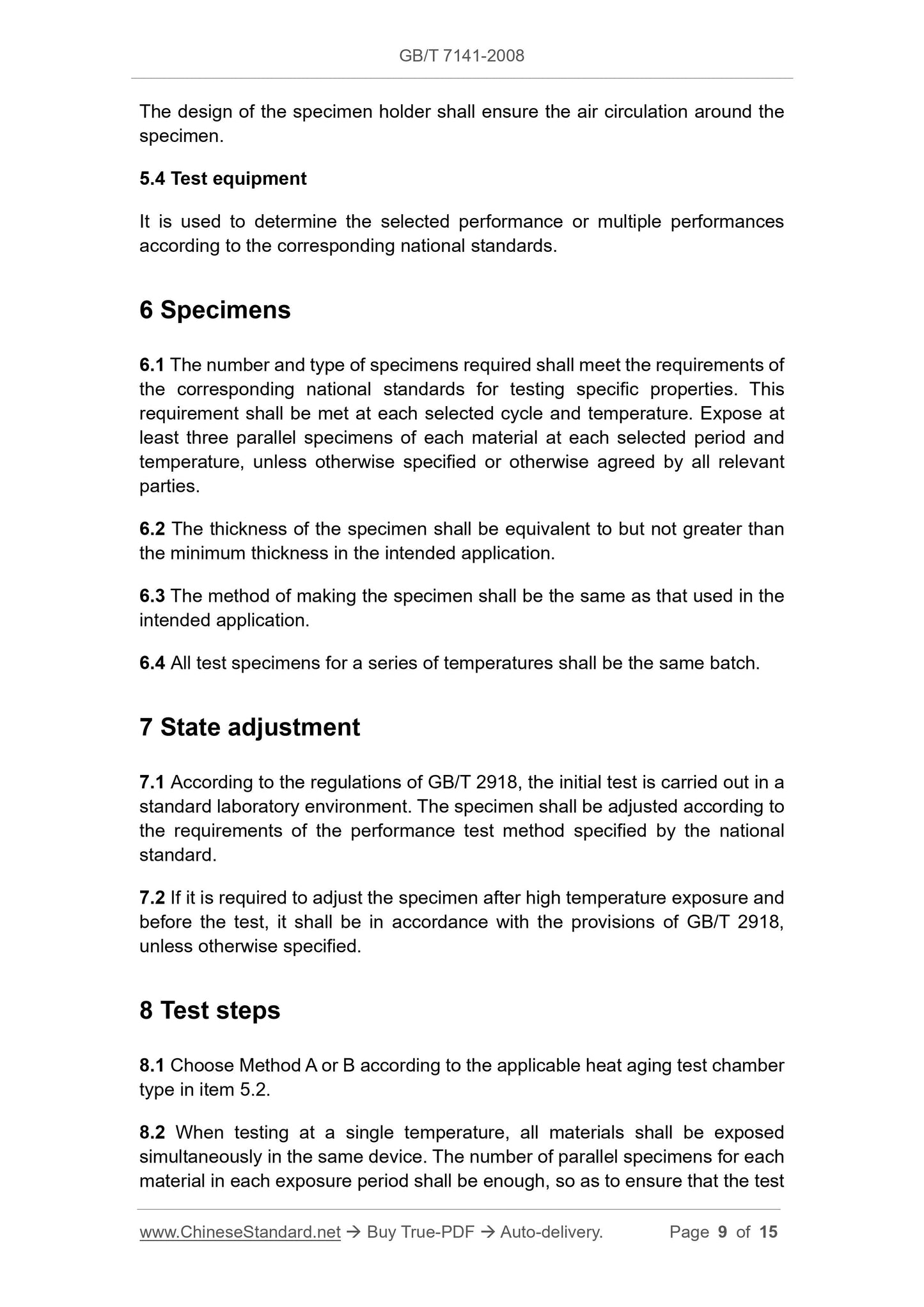1
/
su
6
PayPal, credit cards. Download editable-PDF and invoice in 1 second!
GB/T 7141-2008 English PDF (GBT7141-2008)
GB/T 7141-2008 English PDF (GBT7141-2008)
Prezzo di listino
$115.00 USD
Prezzo di listino
Prezzo scontato
$115.00 USD
Prezzo unitario
/
per
Spese di spedizione calcolate al check-out.
Impossibile caricare la disponibilità di ritiro
Delivery: 3 seconds. Download true-PDF + Invoice.
Get QUOTATION in 1-minute: Click GB/T 7141-2008
Historical versions: GB/T 7141-2008
Preview True-PDF (Reload/Scroll if blank)
GB/T 7141-2008: Plastics -- Methods of heat aging
GB/T 7141-2008
GB
NATIONAL STANDARD OF THE
PEOPLE’S REPUBLIC OF CHINA
ICS 83.080;83.080.01
G 31
Replacing GB/T 7141-1992
Plastics - Methods of heat aging
ISSUED ON: AUGUST 14, 2008
IMPLEMENTED ON: APRIL 01, 2009
Issued by: General Administration of Quality Supervision, Inspection and
Quarantine;
Standardization Administration of the People's Republic of
China.
Table of Contents
Foreword ... 3
1 Scope ... 5
2 Normative references ... 6
3 Terms and definitions ... 6
4 Meaning and application ... 6
5 Equipment ... 8
6 Specimens ... 9
7 State adjustment ... 9
8 Test steps ... 9
9 Result calculation ... 11
10 Test report ... 13
11 Precision and bias ... 14
Annex A (informative) Technical differences between this Standard and ASTM
D5510: 1994 (2001) and their reasons ... 15
Plastics - Methods of heat aging
1 Scope
1.1 This Standard specifies the exposure conditions when plastics are only
exposed to hot air at different temperatures for a long time. This Standard only
specifies the method of heat exposure, but does not specify the test method or
specimen. The influence of heat on any properties of plastics can be determined
by selecting suitable test methods and specimens. This Standard recommends
the use of ASTM D3826 standard to determine the end point of embrittlement.
The end point of embrittlement means that at an initial strain rate of 0.1 mm/min,
when 75% of the tested specimens have an elongation at break of 5% or less,
the material reaches its end point of embrittlement.
1.2 This Standard gives guidelines for comparing the heat aging properties of
materials. These properties are measured by changes in certain related
properties (that is, the embrittlement properties are measured by the decrease
in elongation). This Standard applies to the evaluation of plastics that are easily
oxidized during use.
1.3 The results obtained in accordance with this Standard are affected by the
type of heat aging test chamber used. The user can choose one of two methods
to conduct heat aging test chamber exposure. The results based on these two
methods shall not be confused with each other.
1.3.1 Method A: Gravity convection heat aging test box – It is recommended for
thin specimens with a nominal thickness of not more than 0.25mm.
1.3.2 Method B: Forced ventilation heat aging test chamber – It is
recommended for specimens with a nominal thickness greater than 0.25mm.
1.4 This Standard introduces methods to compare the heat aging properties of
materials at a single temperature. This Standard also describes the method for
determining the heat aging properties of materials at a series of temperatures,
so as to estimate the time required for the material to change its properties at a
lower temperature. This Standard does not predict the heat aging performance
when factors such as stress, environment, temperature and time control failure
interact.
1.5 This Standard does not involve relevant safety instructions. Even if there is,
it is only related to its application. It is the responsibility of users of this Standard
to establish applicable safety and health regulations and to determine
applicable regulatory limits before use.
NOTE: There is no ISO standard equivalent to this Standard.
2 Normative references
The following documents contain the provisions which, through reference in this
Standard, become the provisions of this Standard. For dated references, their
subsequent amendments (excluding corrigendum) or revisions do not apply to
this Standard. However, the parties who enter into agreement based on this
Standard are encouraged to investigate whether the latest versions of these
documents are applicable. For undated reference documents, the latest
versions apply to this Standard.
GB/T 2035, Terms and definitions for plastics (GB/T 2035-2008, ISO
472:1999, IDT)
GB/T 2918, Plastics - Standard atmospheres for conditioning and testing
(GB/T 2918-1998 idt ISO 291:1997)
GB/T 7142, Determination of time-temperature limits of plastics after
exposure to prolonged action of heat (GB/T 7142-2002, ISO 2578:1993,
MOD)
GB/T 11026.4-1999, Guide for the determination of thermal endurance
properties of electrical insulating materials - Part 4: Ageing ovens - Single-
chamber ovens (idt IEC 60216-4-1:1990)
ISO 16014-2, Plastics - Determination of average molecular weight and
molecular weight distribution of polymers using size-exclusion
chromatography - Part 2: Universal calibration method
ASTM D3826:1998 (2002), Standard Practice for Determining Degradation
End Point in Degradable Polyethylene and Polypropylene Using a Tensile
Test
3 Terms and definitions
For the purposes of this document, the terms and definitions defined in GB/T
2035 apply.
4 Meaning and application
4.1 Since the correlation between the results obtained according to this
Standard and the actual use environment has not been determined, these
results are only used for comparison and rating.
taken when using the results obtained from this Standard. When selecting
materials, users must also consider the influence of other factors such as
moisture, soil, and mechanical forces that are consistent with the actual
application.
4.9 In fact, there may be multiple temperature values. Each failure criterion
corresponds to a temperature value. Therefore, to ensure the validity of the
temperature value in any application, the heat aging procedure must be exactly
the same as the intended exposure conditions of the final product. If the final
use of the material is not evaluated by the aging procedure, then the resulting
temperature index is not suitable for this application of the material.
4.10 In some cases, the material can be exposed to a temperature for a specific
period, followed by exposure to another temperature for a specific period. This
Standard is suitable for these applications. After getting the thermal aging curve
of the first temperature, the heat aging curve at the second temperature can be
obtained by exposing the sample after exposure to the first temperature.
4.11 When an Arrhenius curve or equation based on test data at a series of
temperatures is used to estimate the time to reach a specified performance
change at a lower temperature, there may be a very large error. The estimated
time to reach the specified performance change or failure shall always be within
the 95% confidence interval.
5 Equipment
5.1 Environmental conditions
The environmental conditions of the equipment shall provide environmental
state adjustment.
5.2 Heat aging test chamber
5.2.1 Method A: Gravity convection heat aging test box - It is recommended to
use specimens with a nominal thickness of not more than 0.25mm. The heat
aging test box device shall be consistent with GB/T 11026.4-1999 (without
forced air circulation).
5.2.2 Method B: Forced ventilation heat aging test chamber - It is recommended
to use specimens with a nominal thickness greater than 0.25mm. The heat
aging test box device shall be consistent with GB/T 11026.4-1999 (with forced
air circulation). Adopt (50±10) times/h of air exchange rate and keep uniform
test temperature in the box. It is recommended to use a recording instrument
that monitors exposure temperature and humidity.
5.3 Specimen holder
The design of the specimen holder shall ensure the air circulation around the
specimen.
5.4 Test equipm...
Get QUOTATION in 1-minute: Click GB/T 7141-2008
Historical versions: GB/T 7141-2008
Preview True-PDF (Reload/Scroll if blank)
GB/T 7141-2008: Plastics -- Methods of heat aging
GB/T 7141-2008
GB
NATIONAL STANDARD OF THE
PEOPLE’S REPUBLIC OF CHINA
ICS 83.080;83.080.01
G 31
Replacing GB/T 7141-1992
Plastics - Methods of heat aging
ISSUED ON: AUGUST 14, 2008
IMPLEMENTED ON: APRIL 01, 2009
Issued by: General Administration of Quality Supervision, Inspection and
Quarantine;
Standardization Administration of the People's Republic of
China.
Table of Contents
Foreword ... 3
1 Scope ... 5
2 Normative references ... 6
3 Terms and definitions ... 6
4 Meaning and application ... 6
5 Equipment ... 8
6 Specimens ... 9
7 State adjustment ... 9
8 Test steps ... 9
9 Result calculation ... 11
10 Test report ... 13
11 Precision and bias ... 14
Annex A (informative) Technical differences between this Standard and ASTM
D5510: 1994 (2001) and their reasons ... 15
Plastics - Methods of heat aging
1 Scope
1.1 This Standard specifies the exposure conditions when plastics are only
exposed to hot air at different temperatures for a long time. This Standard only
specifies the method of heat exposure, but does not specify the test method or
specimen. The influence of heat on any properties of plastics can be determined
by selecting suitable test methods and specimens. This Standard recommends
the use of ASTM D3826 standard to determine the end point of embrittlement.
The end point of embrittlement means that at an initial strain rate of 0.1 mm/min,
when 75% of the tested specimens have an elongation at break of 5% or less,
the material reaches its end point of embrittlement.
1.2 This Standard gives guidelines for comparing the heat aging properties of
materials. These properties are measured by changes in certain related
properties (that is, the embrittlement properties are measured by the decrease
in elongation). This Standard applies to the evaluation of plastics that are easily
oxidized during use.
1.3 The results obtained in accordance with this Standard are affected by the
type of heat aging test chamber used. The user can choose one of two methods
to conduct heat aging test chamber exposure. The results based on these two
methods shall not be confused with each other.
1.3.1 Method A: Gravity convection heat aging test box – It is recommended for
thin specimens with a nominal thickness of not more than 0.25mm.
1.3.2 Method B: Forced ventilation heat aging test chamber – It is
recommended for specimens with a nominal thickness greater than 0.25mm.
1.4 This Standard introduces methods to compare the heat aging properties of
materials at a single temperature. This Standard also describes the method for
determining the heat aging properties of materials at a series of temperatures,
so as to estimate the time required for the material to change its properties at a
lower temperature. This Standard does not predict the heat aging performance
when factors such as stress, environment, temperature and time control failure
interact.
1.5 This Standard does not involve relevant safety instructions. Even if there is,
it is only related to its application. It is the responsibility of users of this Standard
to establish applicable safety and health regulations and to determine
applicable regulatory limits before use.
NOTE: There is no ISO standard equivalent to this Standard.
2 Normative references
The following documents contain the provisions which, through reference in this
Standard, become the provisions of this Standard. For dated references, their
subsequent amendments (excluding corrigendum) or revisions do not apply to
this Standard. However, the parties who enter into agreement based on this
Standard are encouraged to investigate whether the latest versions of these
documents are applicable. For undated reference documents, the latest
versions apply to this Standard.
GB/T 2035, Terms and definitions for plastics (GB/T 2035-2008, ISO
472:1999, IDT)
GB/T 2918, Plastics - Standard atmospheres for conditioning and testing
(GB/T 2918-1998 idt ISO 291:1997)
GB/T 7142, Determination of time-temperature limits of plastics after
exposure to prolonged action of heat (GB/T 7142-2002, ISO 2578:1993,
MOD)
GB/T 11026.4-1999, Guide for the determination of thermal endurance
properties of electrical insulating materials - Part 4: Ageing ovens - Single-
chamber ovens (idt IEC 60216-4-1:1990)
ISO 16014-2, Plastics - Determination of average molecular weight and
molecular weight distribution of polymers using size-exclusion
chromatography - Part 2: Universal calibration method
ASTM D3826:1998 (2002), Standard Practice for Determining Degradation
End Point in Degradable Polyethylene and Polypropylene Using a Tensile
Test
3 Terms and definitions
For the purposes of this document, the terms and definitions defined in GB/T
2035 apply.
4 Meaning and application
4.1 Since the correlation between the results obtained according to this
Standard and the actual use environment has not been determined, these
results are only used for comparison and rating.
taken when using the results obtained from this Standard. When selecting
materials, users must also consider the influence of other factors such as
moisture, soil, and mechanical forces that are consistent with the actual
application.
4.9 In fact, there may be multiple temperature values. Each failure criterion
corresponds to a temperature value. Therefore, to ensure the validity of the
temperature value in any application, the heat aging procedure must be exactly
the same as the intended exposure conditions of the final product. If the final
use of the material is not evaluated by the aging procedure, then the resulting
temperature index is not suitable for this application of the material.
4.10 In some cases, the material can be exposed to a temperature for a specific
period, followed by exposure to another temperature for a specific period. This
Standard is suitable for these applications. After getting the thermal aging curve
of the first temperature, the heat aging curve at the second temperature can be
obtained by exposing the sample after exposure to the first temperature.
4.11 When an Arrhenius curve or equation based on test data at a series of
temperatures is used to estimate the time to reach a specified performance
change at a lower temperature, there may be a very large error. The estimated
time to reach the specified performance change or failure shall always be within
the 95% confidence interval.
5 Equipment
5.1 Environmental conditions
The environmental conditions of the equipment shall provide environmental
state adjustment.
5.2 Heat aging test chamber
5.2.1 Method A: Gravity convection heat aging test box - It is recommended to
use specimens with a nominal thickness of not more than 0.25mm. The heat
aging test box device shall be consistent with GB/T 11026.4-1999 (without
forced air circulation).
5.2.2 Method B: Forced ventilation heat aging test chamber - It is recommended
to use specimens with a nominal thickness greater than 0.25mm. The heat
aging test box device shall be consistent with GB/T 11026.4-1999 (with forced
air circulation). Adopt (50±10) times/h of air exchange rate and keep uniform
test temperature in the box. It is recommended to use a recording instrument
that monitors exposure temperature and humidity.
5.3 Specimen holder
The design of the specimen holder shall ensure the air circulation around the
specimen.
5.4 Test equipm...
Share
